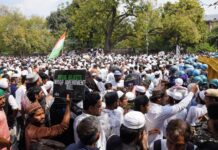Terror attacks carried out by Muslims receive on average 357 percent more media coverage than those committed by other groups, according to research conducted at Georgia State University.
The research highlights a serious imbalance in news coverage.
“What was especially surprising was the sheer amount of coverage granted to the small handful of domestic terrorists who were both Muslim and from outside of the U.S.,” said Allison Betus, a Presidential Fellow with Georgia State’s Transcultural Conflict and Violent Extremism Initiative. “This tiny minority of the dataset accounted for a very large amount of coverage.”
Out of 136 terror attacks in the U.S. over a span of 10 years the authors studied, Muslims committed on average 12.5 percent of the attacks, yet received more than half of the news coverage.
The research team found that factors other than the perpetrator’s religion also affect coverage. When a suspect was arrested, there was a 287 percent increase in news coverage on average, and attacks against the government received 211 percent more coverage. The number of fatalities in a given attack also affected the extent of coverage. The study found that for each additional fatality, an attack received 46 percent more coverage.
The study was led by Dr. Erin Kearns, an assistant professor at the University of Alabama and former post-doctoral research fellow at Georgia State, and Betus, working with Anthony Lemieux, professor at Georgia State and director of the university’s Global Studies Institute.
Researchers looked at all terror attacks in the U.S. between 2006 and 2015. Using information from the Global Terrorism Database, they reviewed national print and online media to analyze coverage.
Subscribe to our newsletter and stay updated on the latest news and updates from around the Muslim world!
“While some may have held impressions that attacks by Muslims are more likely to get more media attention, we got to the bottom of this and quantified it,” Lemieux said. “It’s no longer opinion, perception or conjecture.”
This is the first study to specifically look at how perpetrator religion affects coverage across such a wide scope of terrorism cases, the researchers said. It highlights the inequity in media coverage in the digital age following the Sept. 11 terror attacks. The researchers said this imbalance can create misconceptions about the prevalence of attacks and fuel prejudice and discrimination.






















